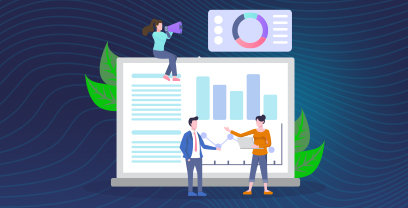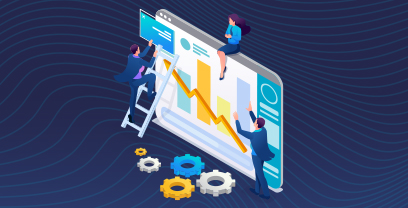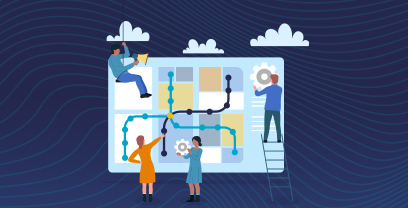A Procurement System refers to a sophisticated framework or software designed to streamline and automate various stages of the procurement process within an organization. These systems come in diverse forms, ranging from best-of-breed solutions to comprehensive full-suite solutions. Best-of-breed solutions often specialize in specific aspects of procurement, while full-suite solutions seamlessly automate multiple process steps.
Organizations leverage procurement software to achieve heightened efficiency, accuracy, and compliance in their procurement activities. By embracing these technological solutions, businesses can optimize their resource allocation, enhance supplier relationship management,gain AI-driven procurement insights through comprehensive analysis and control of spend, and ultimately deliver a framework of continuous procurement process improvement.
In this guide, we look at what today’s procurement systems look like in practice, plus how to evaluate them for enterprise needs.
Key Takeaways
Modern procurement systems streamline the entire Source-to-Pay lifecycle by integrating sourcing, contracting, purchasing, and supplier management into a single platform, enabling better visibility, compliance, and control across the enterprise.
Key capabilities such as automated approval workflows, real-time spend tracking, unified supplier governance, and seamless ERP integration help organizations reduce manual effort, minimize risk, and improve procurement efficiency.
Procurement platforms address common enterprise challenges—including maverick spend, disconnected workflows, and poor supplier data—by providing structure, automation, and actionable insights.
Choosing the right system requires evaluating integration capabilities, workflow configurability, supplier data governance, and analytics tied to business outcomes, all of which are critical for scalable, strategic procurement transformation.
Procurement Systems: Guide on Key Principles, Technologies & Software
Modern procurement software sits at the intersection of cost control, risk management, and enterprise agility, making it critical to business strategy, not just operations. For senior leaders, understanding the core principles, technologies, and capabilities behind today’s procurement platforms is essential to driving impact at scale.
Let’s begin by talking about the functions a procurement system enables in the enterprise.
| Get the details you need to evaluate your next solution. Download our Procurement Platform Datasheet. |
What a Procurement System Delivers Across Your Enterprise
A modern procurement system is designed to drive efficiency and consistency, and support the procurement strategy across every stage of the source-to-pay lifecycle. Rather than using siloed tools, organizations can leverage a unified framework that connects people, processes, and data across departments.
Here are some of the key capabilities a unified procurement system delivers:
- Centralized sourcing, contracts, and supplier data: As part of the procurement systems, strategic sourcing software provides procurement teams with a single source of truth, streamlining collaboration, eliminating redundancies, and enabling faster, more informed decision-making.
- Automated approvals and purchase orders: Built-in workflows reduce cycle times while ensuring activity aligns with internal policies and external regulations. The system should support configurable, multi-level approval hierarchies to route requests based on spend thresholds, risk level, or business function, while automation capabilities can ensure supply chain inventory levels are maintained through automated PO generation.
- Real-time spend and budget tracking features: Consolidating all spend information into a single system provides instant visibility across categories and business units to support strategic sourcing capabilities and better financial planning.. Plus, real-time budget tracking keeps all purchasing activity automatically within budget, preventing cost overruns, while supply chain collaboration software enables suppliers to provide real-time collaborative feedback so that organizations can make agile, multi-variable determinations.
- Unified supplier governance: Manage suppliers through onboarding, compliance, performance, and risk in one platform to strengthen supplier relationships and mitigate exposure.
- ERP system integration: Seamlessly connect procurement with backend systems to eliminate reconciliation issues across the Source-to-Pay process and ensure data accuracy across the enterprise.
Together, these capabilities enable enterprises to scale procurement processes and deliver value through increased control and visibility, and healthier supplier relationships.
Common Challenges Procurement Systems Help Solve
The many capabilities a comprehensive procurement system delivers helps enterprise procurement teams solve the unique set of operational and compliance hurdles they tend to face, especially when processes are fragmented across regions, tools, and stakeholders. It does so by bringing structure, visibility, and Procure-to-Pay automation.
Below are some common challenges and how a robust procurement system solves them.
Disconnected Sourcing and Payment Workflows
When sourcing, contracting, and invoicing happen in isolated systems, cycle times increase and data can get lost during handoffs. Procurement platforms unify these workflows with built-in sourcing software connected to the rest of Source-to-Pay, enabling seamless execution and stronger supplier alignment.
Maverick Spend and Policy Non-compliance
Without guided buying and intake controls, purchases happen outside approved channels. This “maverick” spend leads to budget overruns and audit risk. Intelligent intake management software ensures purchases are compliant from the start.
Inaccurate or Incomplete Supplier Data
When supplier records exist in siloes, duplicate entries are common. Poor visibility and missed risk signals can also cause problems. A unified procurement platform supports data governance and collaboration across supplier onboarding processes and lifecycle management, to help minimize the risk of duplication and human error.
Manual invoice and PO approvals
Paper-based and email-driven approvals slow down procurement and are error-prone. Automated Invoice-to-Pay workflows help to streamline validation and speed processing, while ensuring policy compliance.
Siloed ERP Integrations
When procurement systems aren’t connected to ERP or finance tools, reconciliation becomes a time-consuming, error-prone process. Ivalua integrates natively across multiple ERPs to enable unified data flows. See how Körber eliminated ERP silos with Ivalua.
Limited AI Adoption and Oversight
Many organizations struggle to scale AI in procurement without compromising governance. Agentic AI is gaining traction among leading procurement teams as a way to leverage autonomous decision-making, accelerate routine tasks, and enhance strategic insight across the Source-to-Pay lifecycle. For example, Ivalua’s intelligent virtual assistant approach ensures automation enhances procurement while keeping humans in control.
In the long run, addressing these challenges helps create a resilient and efficient procurement function that’s ready for whatever the future holds.
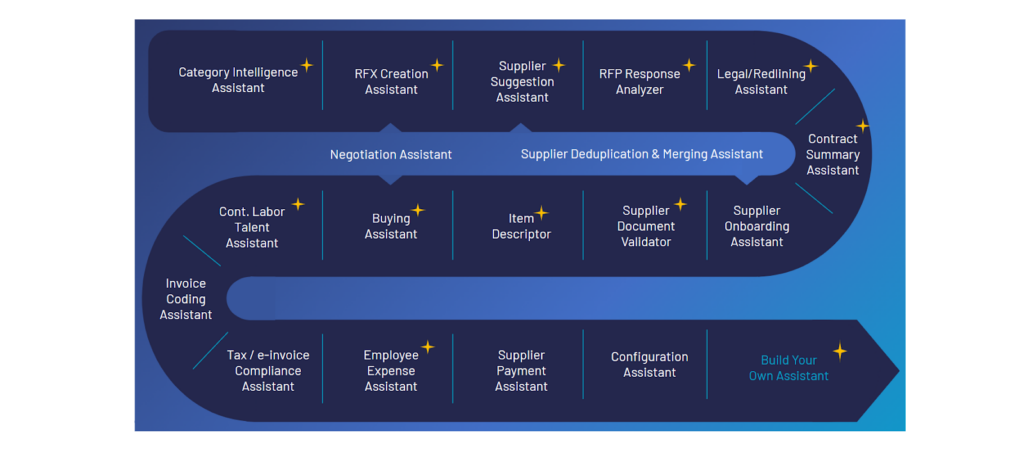
Core Capabilities of a Modern Procurement System
A modern procurement system must go beyond basic functionality to deliver visibility, control, and value across the entire source-to-pay lifecycle. These core capabilities help organizations overcome fragmentation, enforce governance, and make smarter, faster decisions at scale.
Let’s take a closer look at some core capabilities to look for when selecting a modern procurement system for your organizations.
Source-to-Contract Integration
Disconnected sourcing and contracting processes slow negotiations and create handoff errors. A modern platform manages RFX, contract creation, and supplier onboarding in one place, reducing cycle time and risk. Explore our S2P Buyer’s Guide for more details about features to look for.
Approval Workflow Automation
Manual approvals create bottlenecks and inconsistent policy enforcement. Intelligent AI-driven workflows trigger routing based on spend thresholds, risk levels, and category rules, ensuring timely, data-informed decisions.
Supplier Data Management
Siloed or outdated supplier records lead to missed risk indicators and poor inventory collaboration. Centralized vendor management systems consolidate performance, compliance, and risk data into portfolios, to support governance and strategic sourcing.
Invoice-to-Pay Automation
Manual invoicing and payment processes increase errors and delay payments. A unified system with an invoice processing solution automates e-invoicing management, including PO matching, validation, and approvals, giving finance and procurement complete spend control.
Contract Lifecycle Management
Missed renewals and unenforced terms can expose organizations to risk and cost overruns. Contract lifecycle tools track obligations, manage clauses, and support proactive renewals across regions and categories.
Spend Visibility and Reporting
Procurement teams need real-time insights to tie activity to financial and ESG outcomes. Modern systems provide dashboards that connect spend analysis tools and data to performance, risk, and compliance management tools, making it easy to find the insights they need.
Together, these capabilities form the foundation for creating a scalable, efficient procurement function. A procurement system with these features will help your team move faster, work smarter, and drive measurable impact across the organization.
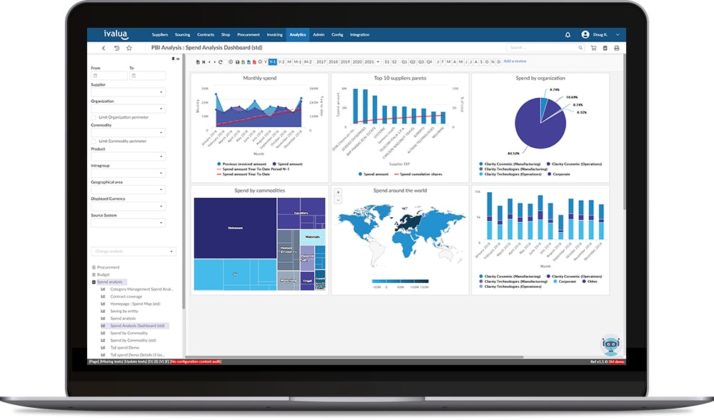
How to Choose the Right Procurement System for Your Organization
Here’s a quick checklist of non-negotiables to help you evaluate and select a procurement system that will deliver long-term value across various types of procurement operations (including both indirect procurement and direct procurement):
- Integrates seamlessly with your existing ERP and finance systems.
- Enables full lifecycle visibility and control with end-to-end Source-to-Pay workflows.
- Offers configurable approval and compliance rules, and allows you to adapt workflows to match your policies, risk thresholds, and business hierarchies without custom code.
- Enables supplier data governance via a single source of truth across onboarding, risk tracking, performance, and compliance.
- Provides real-time procurement analytics tied to business outcomes for faster, more informed decisions.
- Provides procurement dashboard analytics that reflect financial, operational, and ESG impact.
- Provides multi-entity, multi-language support to support complex global operations with capabilities that can be leveraged across business units, geographies, and teams.
- Backed by a Source-to-Pay platform with proven enterprise implementations and a track record of success in complex, high-stakes procurement environments.
Now let’s take a look at a real-world example to see how these capabilities come together in practice.
Customer Story: How Thales Modernized Supplier Collaboration and Data Management
Thales Group, a global leader in aerospace, defense, transportation, and security technologies, was struggling with poor data visibility and process inefficiencies, which made reporting difficult. They were unable to gain actionable insights from their data, and time-consuming data clean-up efforts were holding the team back from engaging and collaborating effectively with their suppliers.
After implementing Ivalua as its master data management solution, Thales was able to transform its supplier collaboration model. With more efficient processes in place, they reduced manual workloads and freed up staff to focus on more strategic priorities.
Read the full Thales case study.
Build a Procurement System That Drives Strategic Value
Procurement is evolving into a driver of growth, resilience, and innovation. To support this evolution, organizations need a procurement system that connects Source-to-Pay processes, enforces governance, and turns supplier data into actionable intelligence.
Leading enterprises are using cloud-based procurement platforms to embed AI, improve ESG outcomes, and respond in real time to shifting market conditions. The right system can actively drive digital procurement transformation and deliver measurable business impact.
Ready to transform procurement into a strategic driver of value? Learn more about how Ivalua’s Procurement Platform can drive enterprise-wide impact.
FAQs
What’s the difference between a procurement system and e-procurement?
e-Procurement solutions typically focus on the transactional elements of purchasing, such as automated requisition processes, catalogs, and purchase order management. A full procurement system connects sourcing, contracting, supplier management, and payments for end-to-end visibility and control.
Can procurement systems integrate with ERP platforms?
Yes, modern procurement software is designed to integrate with ERP and finance platforms to eliminate data silos and streamline reconciliation. Ivalua supports multi-ERP environments to ensure procurement works seamlessly across systems.
What should I look for in a procurement system for enterprise use?
Key features include multi-ERP integration, configurable workflows, robust supplier data governance, and analytics that tie procurement activity to business impact. Scalability, compliance support, and a proven track record of enterprise deployments are also essential.
Is Ivalua a procurement system?
Yes, Ivalua is a comprehensive procurement platform that supports the full Source-to-Pay lifecycle. It enables enterprises to manage sourcing, contracts, suppliers, purchasing, payments, and analytics from a single, unified system.
Further Reading
What is Procurement? Types, Process & Solutions
Optimizing Your Procurement Process: Best Practices, Technologies & Strategies to Succeed


